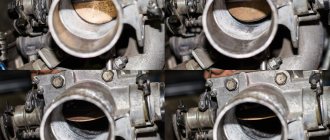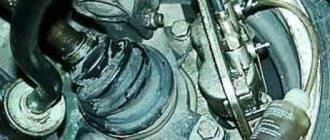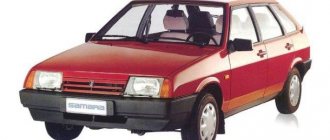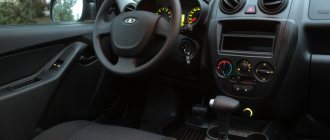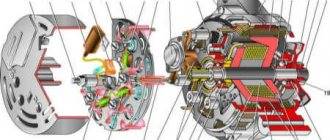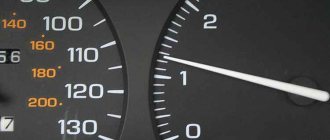VAZ-2109 “Sputnik”/Samara
(
unofficial name “Nine”
) is a Soviet and Russian front-wheel drive car of group II of the small class with a hatchback body. Developed and mass-produced at the Volzhsky Automobile Plant in 1987-2006. From 2007 to the end of 2011, the VAZ-21093 version was assembled from vehicle kits in Ukraine at . It is a 5-door modification of the VAZ-2108 in the Lada Sputnik family of models.
Just add doors: development history and secret of success of the VAZ-2109
Remembering the Finnish Eurosamara Lada Baltic and the four-door sedan VAZ-21099, we slightly ignored the “basic source” - the five-door hatchback VAZ-2109. But in vain, because this model has become a real long-liver among all front-wheel drive vehicles of the eighth family, surpassing even the basic VAZ-2108 in the number of production years and cars produced, which we have repeatedly tested in various trim levels, including the “maximum”. So, today we will remember the history of the appearance and the secret of the unfading popularity of “zero nine”.
What year is the VAZ 2109 injector produced?
The five-door hatchback VAZ-2109 (aka Lada Samara, aka Lada Sputnik) began to be produced in 1986, a year later than the G8. The state price of the car is 8900 rubles.
The car was equipped with a 1.3-liter engine producing 65 hp. s., the gearbox was four-speed, and since 1989 - five-speed. The VAZ-21091 with a 1.1-liter engine (54 hp) was made especially for export.
Since 1990, modernized “nines” with the so-called “long wing” and a different radiator grille began to roll off the assembly line. In the mid-1990s, the car began to be equipped with 1.5-liter engines with a carburetor (70 hp) or an injection system (78 hp). Cars with a VAZ-415 rotary piston engine with a power of 120 were also produced in small quantities. l. With.
Hatchback VAZ-21093, 1990–2005
In 1996-1998, the Lada Samara Baltic was assembled at the Finnish Valmet Automotive plant - a slightly improved version for the European market with a more modern front panel, for which an airbag was even offered as an option.
Hatchback Lada Samara Baltic GL, 1986–1993
In the last years of production, the “nine” was assembled not in Tolyatti, but at the RosLada plant in Syzran (until 2005). They were produced in Ukraine until 2011.
Car history
In 1987, the first “nines” rolled off the assembly line, displacing the then popular eight. The five-door hatchback, with its sporty appearance and excellent dynamics and handling, won the hearts of millions. Against the backdrop of exorbitantly priced and still rare foreign cars, the VAZ 2109 looked very profitable.
“Nine” gained fame abroad. In Russia, both young people and their parents dreamed about it equally. A reliable and safe car, unpretentious in maintenance, has firmly taken its place in the hearts of car enthusiasts. And after the motor rally from Moscow to Lisbon, the VAZ 2109 became simply an idol in its country and the CIS countries.
Presentation of the Lada 99 model
The model is represented by a sedan body, designed for 5 seats, and has 4 doors. Its prototype is VAZ-2109. It was its appearance that was almost completely copied with only one difference: a trunk characteristic of a sedan appeared. Due to this, the car increased in length.
The Lada 99 car was legendary in the 90s. The car participated in almost all films. At that time, this model was considered the most prestigious; in films, “new Russians” rode around in it. We can say that such advertising played a big role in increasing demand for the VAZ-21099. The car was produced for export, however, under a different name. There it is better known as Lada Forma.
The four-door Lada 99 sedan differs from its predecessors in length, as it has been increased by 20 mm. The first lines of the Samara brand are completed by this machine. Production of the car began in 1990 and continued until 2004. Despite the fact that the Lada 99 was soon replaced by new models, it still remains the most common in the CIS and is one of the inexpensive but practical cars.
Generations 2109
1987
2109
1987
21091
1987
21093
1994
21093i
1996
Baltic
LADA 2109
Hatchback
In the Soviet automobile industry, the “nine” had to become the first in many ways. Before the VAZ 2109, not a single domestic automobile company had modifications of the base model with a different number of doors. A pilot batch of 159 five-door hatchbacks was assembled by AvtoVAZ's experimental production department at the end of 1986. “Nine” became the first basic model of AvtoVAZ, the platform of which underwent design changes during mass production. The five-door hatchback was the first to receive standard hydraulic headlight levelers, headlight wipers, a rear window wiper and a rear windshield washer.
Initially, the VAZ 2109, built in 1987, had a short wing and a plastic mask - a beak-muzzle. Despite the criticism, the Lada Samara/Sputnik family featured the most modern design among domestic cars at the time of release. However, the angular geometry of the 1988 VAZ 2109 already in the early nineties began to differ unfavorably from the constantly modernized foreign models. To maintain demand for domestic cars in foreign markets, constant changes were made to the models of the Lada Samara family. Already in 1991, Tolyatti engineers began the Samara-2 project, which involved a radical restyling of the family. The updated five-door hatchback received the VAZ 2114 index and was produced on the main assembly line in parallel with its predecessor VAZ 2109 until 2004.
In the spring of 1989, the VAZ 2109 began to be modernized. The five-door hatchback lost its beak and decorative plastic trim in the corner of the third side window and received the so-called long wing. Versions with short wings continued to be assembled on the AvtoVAZ assembly line until 1994. The 1989 VAZ 2109 was assembled in versions with steel or plastic gas tanks. Instead of a 1.3-liter engine in the line of power units, the base engine was the new Togliatti engine of the VAZ-21083 series with a displacement of 1.5 liters.
Reliability
VAZ 2109 was considered a reliable and safe car. And thanks to the availability of spare parts, it was not difficult to repair it. This workhorse easily overcame any difficulties even when fully loaded. After all, at the time of its appearance, not everyone could afford a car, and therefore relatives with personal cars were mercilessly exploited. And add here the poor quality of roads and we get an ideal workhorse that overcomes any difficulties.
Even now it is recommended as a first car or a car for a summer residence, since the latest generation of the “Nine” costs the money for which, even if you can buy a foreign car, but it’s absolutely dead and then you still have to look for spare parts for it.
“Nine” took a whole milestone in the history of Avtovaz and the whole country. They sang songs about it on stage, and participated in races and international car rallies. This car was the cherished dream of many and could be seen in films more often than other domestic cars. The legendary VAZ 2109 was replaced by the no less stylish VAZ 2114, and then by the Priora. But the “nine” will forever remain in the hearts of the 90s generation as the best car of that time. And despite the fact that production of the “nine” has long been discontinued, it is still on the list of leaders on the secondary market.
Tell me, from what year have the injectors been installed in Samara?
I would like to know, I looked on the internet but couldn’t find it (((
in 97 they already started installing GM in the light
Can you tell me what year the Bosch injector came from?
Boshiki since 2000, although the software is from 1999
Well, since the 97th, some have GM, and some have the usual 4th January
Now suffer with him
What do you mean, suffer? I heard about GM that sensors are expensive and difficult to find, but why is January bad?
it’s old, not all specialists have adapters for it, spy actually said that he doesn’t repair such animals
one sensor costs as much as the entire set of a modern injector
How can you distinguish January from Bosch (during inspection, when purchasing)?
Which January do you want to cure?
It was a 1998 08 and had GM on it.
Not so long ago I read somewhere that VAZ began testing the first Inzhiki in 1994. And they went into production in 1996. I myself am the owner of a 98 with a Bosch 1.5.4 controller.
Was 2109 1998, GM injector, worked perfectly, and still works to this day. There were no problems at all.
You may be as powerful as the Lord God himself, but once someone is found who has the courage to put a hole in your head, you will go to the other world like all other mortals. ” © Don Vitto Corleone.
I just want to buy a Samara from the year 98-99, I want an injection one, so I’m wondering how not to fly by and take it with a normal injector so that later I don’t have to worry about looking for sensors, and I could chip it
well, no one can tell you how to visually distinguish an injector
And here are the labels on the controllers:
Is January a bosh? Or not? And what are the disadvantages of January?
check which unit is in the car. for example, in a classic injection engine, the control unit is located in the area of the passenger side boarding compartment, just below the boarding compartment; in front-wheel drive, I don’t know for sure, but it’s fastest there. in general, on each electric block. control there is a marking to which manufacturer it belongs.
Bosch is not January. These are 2 different controllers. The most normal January is episode 5, I don’t remember all the letters, you can look it up on the Internet. You can do whatever you want with it and there won’t be any problems. There is also January 7th. It is impossible to say that Bosch is better or worse than January since they are almost identical. The same eggs in profile.
Technical characteristics of VAZ 2109
Performance characteristics of the VAZ 2109 nine
Maximum speed: 160 km/h Acceleration time to 100 km/h: 13 sec Fuel consumption per 100 km in the city: 10 l Fuel consumption per 100 km on the highway: 5.7 l Fuel consumption per 100 km in the combined cycle: 7.3 l Fuel tank volume: 43 l Vehicle curb weight: 945 kg Permissible gross weight: 1370 kg Tire size: 165/70 SR13
Engine characteristics
Location: front, transverse Engine capacity: 1500 cm3 Engine power: 78 hp Number of revolutions: 5400 Torque: 115/3000 N*m Power system: Distributed injection Turbocharging: no Gas distribution mechanism: OHC Cylinder arrangement: In-line Number of cylinders: 4 Cylinder diameter: 82 mm Piston stroke: 71 mm Compression ratio: 9.9 Number of valves per cylinder: 2 Recommended fuel: AI-95
Brake system
Front brakes: Disc Rear brakes: Drum
Steering
Steering Type: Rack and Pinion Power Steering: No
Transmission
Drive: Front Number of gears: manual gearbox - 5 Gear ratio of the main pair: 3.9
Suspension
Front suspension: Shock absorber Rear suspension: Coil spring
Body
Body type: hatchback Number of doors: 5 Number of seats: 5 Vehicle length: 4006 mm Vehicle width: 1650 mm Vehicle height 1402 mm Wheelbase: 2460 mm Front track: 1400 mm Rear track: 1370 mm Ground clearance (clearance): 160 mm Maximum trunk volume: 1000 l Minimum trunk volume: 270 l
Production
Year of manufacture: from 1987 to 2006
Specifications
The table below shows the technical characteristics of the main modifications of the VAZ 2109 car:
1. VAZ 2109 “Sputnik” A car with a 1.3 liter carburetor engine
2. VAZ 21093 “Samara” The car was produced with a 1.5 liter carburetor and injection engine
3. VAZ 21093-22 Lada Samara Baltic GL Export version of the car. In terms of technical characteristics, it is practically no different from the VAZ 21093
VAZ 2109 "Sputnik"VAZ 21093 "Samara"Lada Samara Baltic GL (21093-22)GeometryNumber of seatsEngineTransmissionSuspension and steeringSpeed characteristicsBrake systemPerformance characteristics
| Modification name | VAZ 2109 | VAZ 21093 | VAZ 21093i | 1500 GLi/Li |
| Year of release | 1987 | 1990-2004 | 1994-2004 | 1996-98 |
| Body type | Hatchback | Hatchback | Hatchback | |
| Number of doors | 5 | 5 | 5 | |
| Steering wheel position | left | left | left | |
| Wheelbase | 2 460 mm | 2 460 mm | 2 460 mm | |
| Ground clearance | 160 mm | 160 mm | 140 mm | |
| Dimensions / Length | 4,006 mm | 4,006 mm | 4,046 mm | |
| Dimensions / Width | 1 650 mm | 1,620 mm | 1,620 mm | |
| Dimensions / Height | 1,402 mm | 1,402 mm | 1,402 mm | |
| Track / Front | 1 400 mm | 1 400 mm | 1 390 mm | |
| Track / Rear | 1 370 mm | 1 370 mm | 1 360 mm | |
| Weight/Curb | 915 kg | 915 kg | 945 kg | 1,030 kg |
| Weight / Gross | 1,340 kg | 1,340 kg | 1,370 kg | — |
| Total | 5 | 5 | 5 | |
| Name | VAZ 2108 | VAZ 21083 | VAZ 2111 | VAZ 1.5 |
| Location | front | front | front | |
| Orientation | transversely | transversely | transversely | |
| Supply system | carburetor | carburetor | injector | injector |
| Cylinders/valves | R4/2 | R4/2 | R4/2 | |
| Cylinder diameter | 76 mm | 82 mm | 82 mm | |
| Piston stroke | 71 mm | 71 mm | 71 mm | |
| Compression ratio | 9,90 | 9,90 | 9,90 | |
| Volume | 1,288 cm? | 1,499 cm? | 1,499 cm? | |
| Power | 64 hp at 5600 rpm | 70 hp at 5600 rpm | 78 hp at 5400 rpm | 71 hp at 4800 rpm |
| Torque | 94 Nm at 3500 rpm | 106 Nm at 3400 rpm | 116 Nm at 3000 rpm | 118 Nm at 2400 rpm |
| Fuel brand | AI-93 | AI-93 | AI-95 | AI-95 |
| Drive unit | front | front | front | |
| Clutch | Single disc, dry | Single disc, dry | Single disc, dry | |
| Transmission | Manual transmission 5 gears | Manual transmission 5 gears | Manual transmission 5 gears | |
| Steering type | rack type, without amplifier | rack type, without amplifier | rack type, without amplifier | |
| Maximum speed | 148.0 km/h | 156.0 km/h | 155.0 km/h | 156.0 km/h |
| Acceleration up to 100km/h | 16.0 sec | 13.5 sec | 13.0 sec | 12.5 sec |
| Front brakes | disk | disk | disk | |
| Rear brakes | drums | drums | drums | |
| Turning diameter | 11.0 m | 11.0 m | 11.0 m | |
| Fuel tank volume/main | 43 l | 43 l | 43 l | |
| Trunk volume / min | 330 l | 330 l | 330 l | |
| Trunk volume / max | 640 l | 640 l | 640 l | |
| Fuel consumption / in the city | 8.6 l/100km | 8.7 l/100km | 9.9 l/100km | 10.0 l/100km |
| Fuel consumption / on the highway | — | — | 6.2 l/100km | |
| Fuel consumption / mixed mode | — | — | 7.5 l/100km | |
ENGINE
In the role of motors, domestic engineers used various power plants with different volumes and power. The very first Soviet-made models came with a 1.1-liter engine.
The basic version of the “nine” was equipped with a 4-stroke, eight-valve, four-cylinder power unit of the “eight”, the displacement of which was 1,295 cubic centimeters. This “engine” developed 64 horsepower at 5,600 rpm. Peak torque (94 Nm) reached after 3,400 rpm.
The speed limit was 148 kilometers per hour. The first hundred was reached in 16 seconds. Such a modest engine consumed about 8.7 liters per hundred kilometers in city mode and 5.7 liters outside the city.
Option 21093 already has a carburetor engine 21083. It has a volume of 1,499 cubic centimeters. Maximum power of 69 “horses” is achieved after reaching 5,600 rpm. The maximum torque is 106.4 Nm already at 3,500 rpm. The Soviet hatchback can accelerate to 155 kilometers per hour, and the first hundred is reached in 15 seconds.
It is logical to conclude that as power increases, gasoline consumption also increases. So, in the city this figure remains at 8.6 liters per hundred kilometers, and on the highway it drops to 5.9 liters per 100 kilometers. The VAZ 2109 carburetor was called “Solex” and was a new, more economical model.
The most compact is considered to be the 1.1-liter engine, developing only 54 “horses”, which were available at 5,600 rpm. Maximum torque of 79 Nm is available at 3,600 rpm. The maximum speed does not exceed 155 kilometers per hour, and fuel consumption in combined mode is about 6.7 liters per 100 kilometers.
In addition, later they began to produce the VAZ 2109 engine with an injector. It received the index 211180 and was installed in the VAZ-21093i and 1.5 liter volume. This power unit is capable of producing 72 horsepower, available at 5,600 rpm.
Peak torque of 118 Nm is available at 2,800 rpm. For every 100 kilometers, the fuel consumption of the VAZ 2109 is 8.0 liters in the city and 5.8 liters on the highway.
TRANSMISSION
The gearbox for the hatchback initially came with four speeds, but since 1989, the engineering staff decided to introduce a five-speed manual transmission. This transmission has a single-plate simple clutch, a cylindrical final drive, a bevel differential and drive shafts with CV joints.
There is also an integrated center spring and cable drive. The VAZ 2109 gearbox is not very complicated, so some even undertake to repair it on their own.
The design of the Soviet front-wheel drive hatchback has an interesting feature. In order to engage reverse gear, move the gearshift lever all the way to the left and forward. Almost the same principle applies to turning on the first speed.
CHASSIS
At the front, they decided to install a fully independent McPherson-type suspension, which is also called a “floating spark plug.” At the rear they installed a semi-independent suspension with a transverse beam that works on torsion.
In its structure, such a beam is similar to numerous front-wheel drive cars of past years. Hydraulic shock absorbers, cylindrical springs, as well as lower wishbones with braces and a stabilizer bar are used.
As a braking device for a front-wheel drive car, disc brakes with movable calipers in front and drum mechanisms in the rear are used. The distance between the disc and the pad is adjusted automatically. The brake drive of the machine is represented by the hydraulic method.
Salon
Especially for the new series of cars, the Volzhsky Automobile Plant abandoned the Zhigulevsky exterior, creating a completely new interior. The car is arranged so that the driver can easily and comfortably reach everything. The model has 3 types of panels: high, low and euro. In the luxury configuration, the car was equipped with electric windows. It is worth noting that the seats have now become more comfortable, which contributes to a more comfortable ride. The rear sofa is small, as it was intended for children, but in the dashing 90s, 2-3 large guys could fit there.
This is an ideal car for a novice driver and work. The car is characterized by high maintainability, inexpensive parts and wide scope for tuning the interior, engine, and appearance.
About LADA 2109 engines 1st generation (1987 - 2011)
VAZ 2109 (Lada Samara), popularly known as a nine, is a five-door hatchback, a continuation of the Samara line.
It was developed in 1987 using the three-door hatchback VAZ 2108 as a basis. The nine itself became the basis for the creation of the VAZ 21099. The car became widely popular thanks to its rapid design, good engines for those times, as well as a practical five-door body. All this, coupled with its low cost, as well as a wide selection of spare parts, made the VAZ 2109 very attractive. This attractiveness was passed on to its successor, the VAZ 2114. In contrast to the VAZ, the injector was installed as standard on the 2109 engines (power unit 2111).
In addition to the injector, the 2109 was equipped with a carburetor with a displacement of 1.1 l, 1.3 l and 1.5 l. Such engines can be seen if you look under the hood of the 2108.
In the article we will look at the engines themselves for the VAZ 2109, their characteristics and weaknesses.
ENGINE VAZ 2108
The 1.3 engine is the base for the eight, it was developed from scratch, and is structurally similar to the 21011 1.3 liter engine. there is nothing in common. This engine became the basis for the creation of power units for installation on the Samara family with a displacement of 1.1 liters and 1.5 liters. This is an in-line carburetor type engine, has 4 cylinders and an overhead camshaft. The timing drive uses a belt.
Regarding the service life of the engine, it is fair to say that careful and quiet operation, proper and constant maintenance will allow you to exceed the official 120 thousand km and the service life can be 180-200 thousand km.
In terms of disadvantages, the following are most often noted. The parts of the cooling system wear out quite quickly. Frequent oil filter replacement and valve adjustment will be required. Oil leaks often occur due to unreliable seals of the valve cover, fuel pump and distributor sensor. It should be noted that unreliable Solex-type carburetors in general, and EPHH in particular.
If the timing belt breaks, the valves may bend. Also, over time, problems with ignition and engine tripping may occur. In addition, due to ignition problems, the engine may detonate. Another reason for this may be low-octane, low-quality fuel. Detonation is indicated by black smoke coming out of the exhaust pipe and loss of power.
ENGINE VAZ 21081
Engine VAZ 21081 1.1 l. is an analogue of the power unit 2108 1.3. However, it has a crankshaft of less stroke, and as a result, reduced traction. This is an in-line carburetor-type engine with four cylinders, an overhead camshaft, and a timing belt. As for the resource, if you ensure careful operation and quality maintenance, you can count on an official 125 thousand km.
The difference between 21081 and 2108 is due to the reduced piston stroke and, as a result, the reduced displacement. In addition, the difference is a lower cylinder block compared to 2108.
The VAZ 081 engine is rare, as such engines were exported. This is probably for the best, since this is a frankly frail unit. It should also be remembered that if the timing belt breaks, the engine may bend the valves. ENGINE VAZ 21083 This engine is the progenitor of the current power units for Lada; it became the basis for 16 valve engines 2112, 124, 126 for Priora, 127, 114, 116, 194 for Kalina.
The replacement for this engine was the same injection-type version. VAZ 2108 1.5 l. is an in-line carburetor-type engine with four cylinders and an overhead camshaft. The timing drive uses a belt; if it breaks, the valve slide will not bend.
If we talk about the weaknesses of the engine, we need to mention the following. The valves need to be adjusted. Parts of the cooling system wear out quickly. Frequent oil filter replacement and valve adjustment will be required. Oil leaks often occur due to unreliable seals of the valve cover, fuel pump and distributor sensor. It should be noted that unreliable Solex-type carburetors in general, and EPHH in particular.
The fastenings of the exhaust pipe may break off, since steel nuts are used rather than brass. In addition, the engine may knock, which indicates the need to adjust the valves. The engine may misfire, and in this case the cause must be sought in the valves, a clogged carburetor, or faulty electrics.
ENGINE 2114 / 2111
The VAZ 2111 engine, which is popularly called 2114, is generally the eighty-third engine. However, unlike 21083, 2114 uses an injector rather than a carburetor. In addition, the 2114 is characterized by the presence of a floating connecting rod pin and a different camshaft. Finally, the 2114 has more power. Engine VAZ 2114 1.5 l. in-line, injection, with four cylinders, has an overhead camshaft, the timing drive uses a belt. In this case, if the belt breaks, the valve slider does not bend.
As for the shortcomings, the following are noted. It is necessary to adjust the valves, parts of the cooling system wear out quickly, frequent replacement of the oil filter is required, problems with the valve cover seal, fuel pump and distributor sensor. The exhaust pipe fastenings may break because steel nuts are used rather than brass. In addition, the speed often begins to float. The engine may trip. Often the engine does not warm up to the desired operating temperature. The problem is most likely with the thermostat. In addition, the engine may knock and make noise, usually due to unadjusted valves.
SAFETY
The dashboard takes impacts tightly. The controls, along with the headrests and other elements, were made of soft plastic. The factory provided sun visors, so as not to blind the driver, which were covered with cladding. Additional sun protection is provided by easily adjusting the placement of the interior mirror.
The plant workers provided a system of mutually moving elements that absorb the impact force, combined with a carriage that moves to one side, which, using an adjustable delay, reduces the collision energy with the steering wheel. The aspherical concave external mirror increases the viewing range.
Estimating the distance to the car following behind will only be symbolic, since there is a slight distortion. The designers of the VAZ 2109 provided seat belts not only in the front seats, but also for those sitting in the rear. Such an element can save more than one life!
The car received three-point seat belts, with an automatically winding device and a locking device, which provides full independence of activity at a calm speed mode, while at the same time clasping the torso tightly and with tension.
During strong acceleration or deflection of the machine, the belt is quickly locked in all directions. This option is not tested by special sudden movements of the body.
Design differences
What is the difference between 2109 and 21099?
Even though these two cars are very similar, there are still some differences between them.
So, 21099 had the following features:
- A different radiator grille configuration.
- Instrument panel with a tachometer (early versions).
- The rear overhang of the body has been increased by 20 centimeters.
Variations
VAZ 2109 and 21099 had modifications with identical technical characteristics.
Therefore, it is more logical to present only the power units with which these models were equipped:
- The engine is 1.3 liters with an output of 64 horsepower.
- The engine is 1.5 liters, producing 70 horsepower.
- Installation of 1.5 liters with fuel injection system. Develops 78 “horses”.
All engines were equipped with a five-speed manual transmission.
It is worth noting that later versions of Lada 21099 received a 1.6 liter engine that produced 81 horsepower. In addition, its power range lacked a 1.1-liter unit, which was equipped with both the Nine and Eight.
Car injector breakdowns
Quite often a situation arises when a fuel-injected car starts poorly or does not start at all. The reasons for this operation may be dirty spark plugs from low-quality fuel, problems in the operation of the generator, starter, or insufficient current in the battery. The main malfunction is the low fuel supply to the injector frame; accordingly, an insufficient amount of fuel is sprayed by the injectors.
The fuel pump is responsible for supplying fuel to the injector; it may not produce the pressure necessary for normal operation of the car engine. In this case, it is best to replace the pump. If the reason is not a pump failure, then it will be enough to replace the filter in it. Another common cause of malfunction is the failure of one or more injector nozzles. Low-quality fuel, which sometimes, against our will, enters the system, contains various additives that are deposited on the injectors and interfere with proper operation.
When the injectors become dirty, the vehicle's fuel consumption increases noticeably and the vehicle's traction decreases. If fuel is not supplied in the amount required for engine operation, then the speed on the tachometer begins to fluctuate. In all injection VAZ cars, the average engine speed at idle should not exceed 900 rpm.
Love 24 years long
“Nines” almost immediately appeared in the showrooms of European Lada dealers, and very rarely - in authentic form. To please the jaded Western consumer, dealers equipped the cars with music, alloy wheels and exterior decorative elements.
They often reupholstered interior elements and changed the steering wheel, trying to make the five-door Samara more attractive in the eyes of a potential buyer.
| At a minimum, caps and a different radiator grille are what distinguished the export European “nine” from the Soviet one |
| European dealers even reupholstered the interior with a different fabric, improving the lateral support of the seats! |
| In the “top” versions, the front seats could be completely replaced |
French, Belgian and English importers went even further, installing an aerodynamic body kit on the Nine with new elements such as a spoiler on the trunk lid.
| Some dealers even customized their own identification plate! |
New optics were also not uncommon - for example, the four-headlight French Morette or the German Hella. Well, the radiator grille on the “short wing” was changed on almost 100% of dealer VAZ-2109s.
The success of the “nine” in Europe was also facilitated by an unusual “promotional event,” as they would put it in our time. Soviet auto journalists (and a few motor sportsmen) from the Za Rulem magazine decided to “catch up and overtake” the Portuguese, who in 1986 arrived from Lisbon to Moscow in 51 hours and 30 minutes.
| The cover of the January issue of “Behind the Wheel,” as well as the spread, is dedicated to the run of Soviet auto journalists from Moscow to Lisbon in a cherry-colored VAZ-21093 |
"Our Answer to Chamberlain" took place in September 1988. Of course, the ambitious trans-European marathon “Moscow-Lisbon” was preceded by serious preparation at the state level: the development of the diet and training of the crew was undertaken at the Research Institute of Medical and Biological Problems of the USSR Academy of Sciences. It was decided to drive the “best of the best” - that is, a one and a half liter “nine” with a five-speed gearbox. A thoroughly run-in (but still production) car with Michelin tires on Melber alloy wheels and a Hella rally “chandelier” on the front end managed to “fly” from the 50th Anniversary of October Square in the center of Moscow through the entire then ununited Europe to the gates of Lisbon in 45 hours, covering 4,811 km at an average speed of 107 km/h. The constant actual speed for a third of the way was 150-170 km/h. It is not surprising that the dusty cherry “nine” took pride of place in the Lada exhibition at the Paris Motor Show, impressing visitors with its achievement. True, the French importer asked VAZ to remove the “1500” nameplate from the trunk lid, since this version of the Samara had not yet been delivered to Europe.
But even in the already dying USSR, the five-door version was treated with warmth and respect. Yes, it’s smaller than a Zhiguli, but it’s so modern, dynamic and maneuverable! And at this time at VAZ Samara they just started painting with newfangled metallics. Many young readers will find it difficult to understand the level of “coolness” of the latest Lada model, the color “wet asphalt” or “currency”... It is not surprising that strong young people of athletic build, dressed in leather jackets, who became masters of life for a while, immediately chose the “nine” as a “a vehicle for every day”, driving around in prestigious new VAZ-21093 to their “arrows”, “showdowns” and simply to collect tribute from market entrepreneurs.
The new VAZ models of the tenth family have somewhat damaged the prestige of the “zero ninth”, but not so much that it was immediately abandoned in favor of a “crude” and not so “driver” new product. The phenomenon of the success of the five-door “nine” was that it suited both “bandos” and ordinary Russian citizens equally well. And the Europeans still used the “nine” - albeit in the form of an updated Lada Baltic, produced for a couple of years at the Valmet plant in the Finnish city of Uusikaupunki.
But for the domestic market, they began to prepare a replacement for the “chisel” - more precisely, an update in the form of Samara-2, modernized inside and out.
| The version of the VAZ-21093 with distributed injection could be identified by the 1500i nameplate |
Having managed to try on the “injection” engine of the VAZ-2111, the five-door Samara in a long-winged guise and with a high panel lasted on the assembly line in Tolyatti until 2004, giving way to the “four”. But the life path of the “nine” did not end there: from 2004 to the end of 2011, the VAZ-21093 was produced from vehicle kits in Ukrainian. Thus, the “zero ninth” was produced for almost 25 years, while the VAZ-2108 was produced for twenty. And there were twice as many five-door Samaras produced in Tolyatti alone as “zero eights” - more than one and a half million VAZ-2109s against 884 thousand “eights”.
ADVANTAGES OF THE MACHINE
- Inexpensive Soviet-made car;
- Front-wheel drive can certainly be considered an advantage;
- Acceptable ride height;
- Good dynamics, high speed, pleasant handling and sufficient stability on different surfaces;
- Heating and ventilation cope well with their tasks and supply air to several points at once, which improves the uniform distribution of thermal air throughout the cabin;
- Acceptable fuel consumption;
- Ideal for tuning;
- Availability of spare parts and good maintainability.
DISADVANTAGES OF THE CAR
- Corrosion of metal;
- The appearance is clearly not for everyone;
- A small resource of some details;
- Mediocre sound insulation of the cabin;
- Low equipment;
- There is very little free space, especially for rear passengers;
- Small luggage compartment;
- Poor maneuverability;
- Poor quality interior;
- Low level of security;
- The power unit clearly lacks power.
Sources
- https://www.kolesa.ru/article/prosto-dobav-dverej-istoriya-razrabotki-i-sekret-uspeha-vaz-2109-2
- https://vazweb.ru/info/vaz-2109.html
- https://www.syl.ru/article/226693/new_lada—legenda-otechestvennogo-avtoproma
- https://www.drive2.ru/cars/lada/2109/m1498/
- https://kuruh.ru/vaz-2109-devyatka
- https://vaz-2109.ru/texnicheskie-xarakteristiki.html
- https://zen.yandex.ru/media/all_auto/istoriia-vaz-2109-tehnicheskie-harakteristiki-foto-video-polnoe-opisanie-5b1d170bbce67ee9778d5da1
- https://autoiwc.ru/lada/vaz-2109.html
- https://AutoVogdenie.ru/lada-vaz-2109-21099.html
- https://www.drive2.ru/cars/lada/2109/g2173/
- https://fishki.net/auto/3339038-rannjaja-devjatka-vaz-2109-s-dlinnym-krylom-1990-goda-vypuska.html

